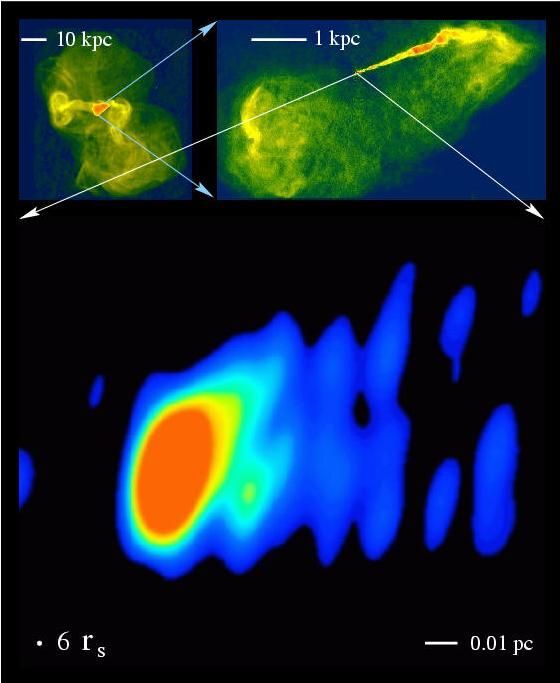M87 Jet Formation Region
Description
M87 is a giant elliptical near the center of the Virgo cluster of galaxies, nearly 50 million light-years away. At the center of the elliptical galaxy lies a super-massive black hole, weighing three billion times more than the Sun. Material being drawn inward by the strong gravitation of the black hole is formed into a rapidly-spinning flat disk, called an accretion disk. The subatomic particles are thought to be pushed outward from the poles of this disk. The scientists believe that magnetic fields in the disk are twisted tightly as the disk spins and then channel the electrically-charged particles into a pair of narrow jets. The charged particles travel at highly relativisitc speeds as they spiral around the strong magnetic fields which collimate the jet, and as they do so they emit copious amounts of radiation at radio wavelengths. The above image shows views of M87 at different spatial scales. The bottom image is a 7mm (43GHz) VLBA image of the very central regions of the jet deep in the heart of the elliptical galaxy. Red (blue) represent regions of brighter (fainter) radio emission. The white bar indicates a distance of 0.01 pc (0.0326 light-years), or 2,062 times the distance from the Earth to the Sun. This image shows that M87's jet is formed within a few tenths of a light-year of the galaxy's core. In the formation region, the jet is seen opening widely, at an angle of about 60 degrees, nearest the black hole, but is squeezed down to only 6 degrees a few light-years away. The small circle labeled 6Rs shows six times the Schwarzschild Radius, (radius of the event horizon) for the galaxy's super-massive black hole. That length corresponds to slightly more than 9 times the distance from the Sun to Pluto. The top two images are from the VLA, and show the radio jet and lobes at much larger spatial scales. The scales of the images are shown by white bars in each image: 10 kpc (kiloparsecs) is equal to 32,600 light-years, and 1 kpc equals 3,260 light-years. The top right image was made from observations at a wavelength of 20cm, and shows the jets of subatomic particles coming from the core are seen to balloon into large lobes of radio emission. In the even larger scale image in the top left, taken at 90cm, the inner lobes are seen to be smaller features in more extensive radio bubbles, which extend well outside the elliptical galaxy into the surrounding intracluster medium.
The structures seen at the longer wavelengths (i.e., 90cm), are larger in part because as the particles travel outward, they radiate at lower and lower energies, which corresponds to longer and longer radio wavelengths. As a result, by looking at longer wavelengths we see radiation from the oldest particles, which are the ones which travel the greatest dstance. M87 also is known by radio astronomers as Virgo A, the strongest emitter of radio waves in the constellation Virgo. The galaxy was discovered by the French astronomer Charles Messier in 1781. The jet was first seen in 1918 by Lick Observatory astronomer Heber Curtis, who described it as "a curious straight ray." The galaxy's radio emission was first observed by Australian astronomers in 1948/49. M87 is the largest of thousands of galaxies in the Virgo Cluster of galaxies. The Local Group of galaxies, of which our own Milky Way is a member, is in the outskirts of the Virgo Cluster.
Creator
Legacy Astronomical Images
Rights
NRAO/AUI/NSF does not hold full copyright for this image. Contact the archivist for details.
Type
Legacy Astronomical Image
Object Name
M87
Investigators
W. Junor, J. Biretta, M. Livio
Telescope
Very Large Array (VLA)
Very Long Baseline Array (VLBA)
Observation Date
1999-00-00
Type of Observation
continuum
Band
Q
Wavelength
7 mm
Frequency
45 GHz
Center of Image
RA 12:30:49.420, Dec: 12:23:28.000 (J2000)
Field of View
0.250000 x 0.250000 degrees
Link to journal article
Series
Active Galactic Nuclei Series
Unit
Quasars Unit
Citation
Legacy Astronomical Images, “M87 Jet Formation Region,” NRAO/AUI Archives, accessed June 7, 2025, https://www.nrao.edu/archives/items/show/33341.

